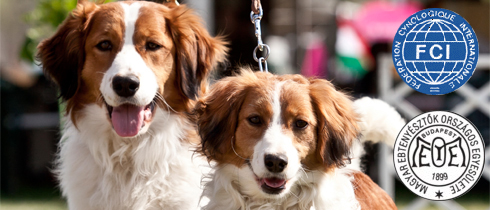STANDARD
![]()
DUTCH KOOIKERDOG
Kooikerhondje Standard
This was taken from the Dutch Kooikerhondje Clubs Breeding rules as stated above.
Origin: The Netherlands
Characteristics: The little spaniel which worked formerly and still is working successfully in duck decoys is a true sporting dog with a lively temperament. It is harmoniously built. Its coat is shiny, nicely colored and well feathered.
Classification F.C.I.: Group 8, Section 2 (flushing dogs)
Short historical survey: This Dutch breed is now officially recognized. The interim standard was approved by the "Raad van Beheer" on June 18, 1966.
As she had done with numerous other breeds, Baroness van Hardenbrock van Ammerstol added another jewel to the Dutch breeds. Good quality specimens in sufficient number are now being bred. The annual meeting of the Kooikerhondje played an important part in the developing of this sporting breed.
General Appearance: Agile parti-colored dog with a nearly square body. It has a well feathered tail and an uplifted head.
Important proportions: The length is slightly more than the height at shoulder. Length of the skull about equal to the muzzle.
Temperament: Cheerful, not noisy, easily kept, very dependent on its domestic environment, friendly, good natured and alert.
Head
Skull: Sufficiently broad, moderately domed.
Stop: Clear, but not too deep.
Nose: Black
Muzzle: Not too deep in profile.
Lips: Not overhanging.
Cheekbones: Well filled.
Pattern: A blaze is preferred; colored cheeks.
Eyes: Almond shaped, deep brown with a friendly, alert expression.
Ears: Medium sized, set on just above the line from the point of the nose to the corner of the eye; no white; hanging close to the cheeks. Long feathered, black tips (earrings) are preferred.
Teeth: The standard bite is scissors, pincer bite admitted.
Neck: Straight and well muscled.
Body:
Back:Strong
Brisket:Deep with sufficient spring of ribs.
Tail:Carried on level with the back or slightly above; not curled.
Legs and feet:
Forelegs: Straight and not to heavily feathered.
Hindquarters: Breeches long feathered: No feathering below the hock; the tarsal joint sufficiently angulated.
Feet: Small, with the toes close; covered with short hair.

Coat
Hair:Medium long, with a slight wave or straight; no curls and close fitting. Hair not too fine, well developed undercoat.
Color: Distinct and clear orange red patches on white. Color should be dominant. Black and white and three colored dogs are not admitted.
Gait / Movement: Should be flowing and springy, not stepping.
Height: At shoulder from about 35 to 40 cm (14-16 inches)
Male animals should have two apparently normal testicles fully descended in the scrotum.
The character of the Kooikerhondje is described as follows:
The Dutch Kooikerhondje has an attractive, friendly appearance. But there is a lot of temperament in this breed. For the original work in the duck decoy steady self assured behavior was a must since the ducks were lured and not chased. The dog works with a waving bushy tail, a sign of sufficient confidence. He had to walk calmly alongside and between the fences from the 'Decoy', so the dog could be seen clearly in several different places for a short period of time by the ducks. This stimulated the curiosity of the ducks, who were lured by this and followed swimming further and further into the catch-pipe and finally into the trap, where they could be caught by the decoy-man (kooiker). At the end the ducks went "de pijp uit" ("out of the pipe" a rude Dutch expression for to die). They were either killed for consumption or ringed for ornithological research.
Outside the hunting season the dog had to destroy vermin. For which a certain fierceness, rapidity and hardness was required. The do-operation with the decoy-man for all the work in the decoy was a must. Hence the attentive attitude and the will to please. The work demanded perseverance and stamina as well.
Today's Kooikerhondje should still have all these necessary qualities. Aggression caused by fear or overly dominant behavior towards people and dogs is definitely undesirable. The dog should go free and fearless around the show ring with sufficient confidence to allow himself to be handled by the judge with friendliness and indifference. Ducking away and//or lunging indicate fear and is an obviously undesirable behavior.
![]()


